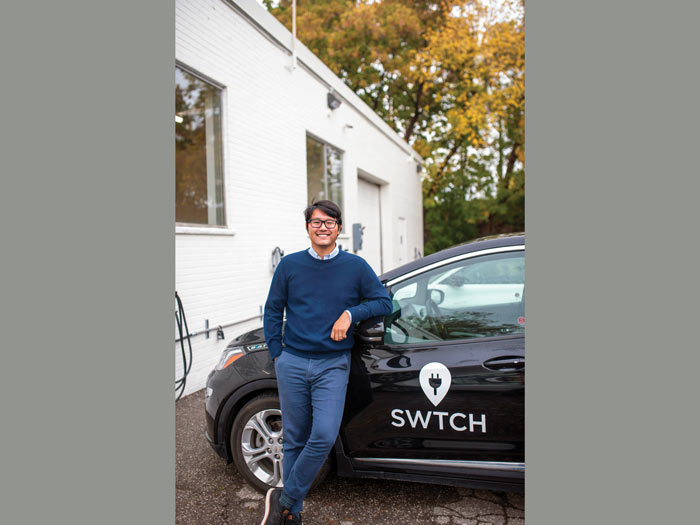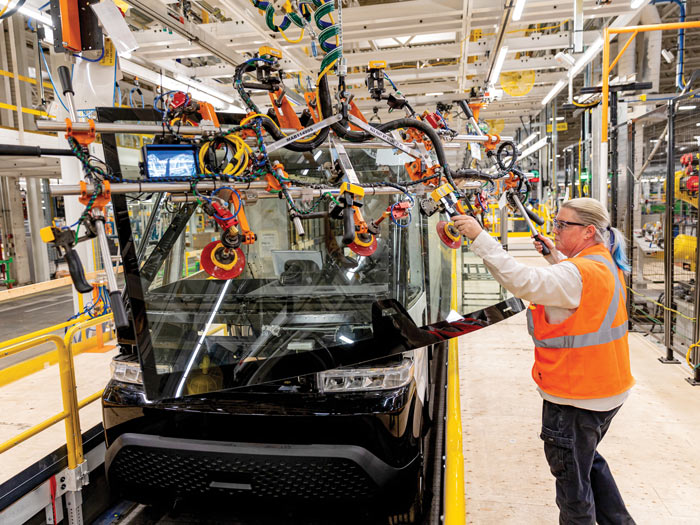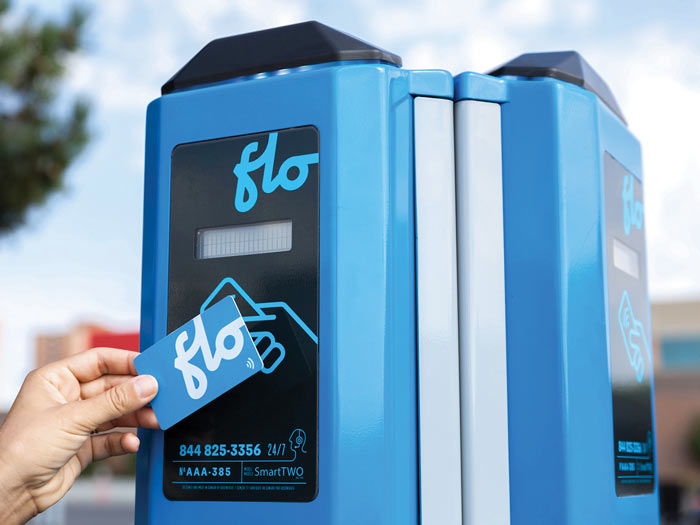
Here are the people creating an outlet for change
 Carter Li, CEO and co-founder of SWTCH Energy (Courtesy of SWITCH Energy)
Carter Li, CEO and co-founder of SWTCH Energy (Courtesy of SWITCH Energy)
In 2015, Carter Li, a Toronto-based management consultant and sustainability enthusiast, found himself hitting a roadblock. Li was eager to reduce his carbon footprint and make the switch to an electric vehicle. Since he lived in a condominium downtown, he figured it would only be realistic to buy one if his building had an electric vehicle (EV) charging station. He made a proposal to his condo board, offering to pay the estimated $30,000 required to install a charging station as an amenity accessible to all residents. To his surprise, they turned him down, citing a lack of demand—there were only about 7,000 EV purchases nationwide that year—and more pressing priorities.
Eight years later, as global temperatures continue to rise and climate change-related disasters become alarmingly frequent, EV adoption has become a priority for governments, manufacturers and many consumers. On-road transportation emissions account for 20 per cent of Canada’s total greenhouse gas emissions. As part of its efforts to achieve a net-zero emissions economy by 2050, the federal government has set an ambitious target of phasing out the sale of new gasoline-powered cars and light-duty trucks by 2035. On the production side, Greig Mordue, an auto manufacturing expert and engineering professor at McMaster University, insists that the philosophy behind EV manufacturing is mostly similar to that of non-EV. Last winter, the first Canadian-made all-electric vehicle rolled off the assembly line at a GM plant in Ingersoll, Ont. “Every five years or so, a car manufacturing plant needs to retool for the next generation of the model it makes,” says Mordue. “The only difference now is that the model changes and retools being announced are for cars powered by batteries rather than the traditional internal combustion engine.” While this relatively seamless transition won’t resurrect the Canadian auto manufacturing industry or bring back shuttered factories that have relocated overseas, it will help bring the average EV price down for the Canadian consumer.
But the challenges Carter Li faced back in 2015 are still largely the same. The federal government offers rebates of up to $5,000 for Canadians who switch to EVs: as of early 2023, more than 185,160 incentives have been provided to Canadian consumers and businesses. And yet, EVs comprised just 7.5 per cent of all new vehicle sales in 2022. Experts point to one major hurdle preventing faster adoption: Canada’s infrastructure is woefully inadequate to support the number of EVs on the roads, let alone the new ones to come. “The focus has often been on making EVs cheaper, but for many consumers, it’s a chicken and egg situation with EV adoption,” says Li. If people can’t easily charge their vehicles at home or on the road, they won’t buy EVs. If they don’t buy EVs, businesses won’t have the incentive to invest in charging infrastructure. Currently, there are more than 20,000 chargers accessible to the public in 8,700 locations across Canada. But according to a recent study from energy consulting firm Dunsky, Canada will need nearly 900,000 charging ports by 2050. This entails nearly $20 billion in public and private investments over the next three decades. Without a proper network of charging stations, the government’s goal of 100 per cent zero-emission vehicle sales within the next 12 years will be impossible to achieve.
A key challenge in building that infrastructure is that not all EV chargers are created equally, or serve the same purpose. EVs in Canada utilize three different levels of charging. Level 1 charging uses a standard 120-volt household outlet, similar to the one used for a toaster or TV. Depending on the charger and battery size, it can take up to 20 hours to fully charge an EV with Level 1 charging. Level 2 charging is the most commonly used method for daily charging: it’s usually installed at public charging stations and workplaces, but homeowners can add them to their residences. It takes up to seven hours to fully charge a regular EV using Level 2 charging, thus providing a significantly faster charge than Level 1. Finally, Level 3 charging, also known as direct current fast charging (DCFC), can be found at charging stations along highways and can charge an EV from empty to 80 per cent in 30 to 45 minutes, making it ideal for longer trips. Most publicly available chargers in Canada are Level 2 chargers, and there are over 1300 DCFC stations nationwide. In the long-run, Canada’s EV public charging infrastructure will need to rely on far more DCFC stations. Each level of charging requires unique specialization, expertise and capital investment, with limited current potential to scale up and drive down costs.
 A GM plant in Ingersoll, Ont., recently converted to EV manufacturing (James Cooper)
A GM plant in Ingersoll, Ont., recently converted to EV manufacturing (James Cooper)
Despite those impediments, a growing number of Canadian companies are entering the space to build up the country’s charging infrastructure. Quebec company FLO is the biggest domestic player, running a network of 80,000 Level 2 and 3 EV charging stations at primarily public locations spanning North America. Founded in 2009, FLO develops, manufactures and manages its charging stations in-house, with the goal of accelerating EV adoption Canada-wide. “People are reluctant to drive long distances using their EVs, such as on inter-provincial highways, because they need to know that they can charge their vehicles on the way when they need to,” says Frédérique Bouchard, FLO Public Affairs Manager. “Investing in charging infrastructure helps [to] alleviate range anxiety and convince more Canadians to adopt EVs.” Each month, FLO’s network enables more than one million charging events. Yet, public chargers in Canada are often broken and poorly maintained. “A charging station is a promise to EV drivers,” says Bouchard. “To fulfill that promise, FLO installs stations that are connected to a network, monitors them and ensures swift or preventive repairs when needed. As we build a large-scale charging infrastructure, we need solid foundations, and the last thing we want is unreliable chargers weakening that foundation.”
While FLO is transforming the public charging space, other companies are tackling the largely neglected domain of private charging for the quarter of EV owners who don’t have home charging and the many more who lack convenient access to public charging. “Solving the specific problem of public charging is important for traveling long distances, but the average EV driver only uses public charging about three times a year,” says Carter Li, the Toronto condo dweller who failed to convince his building to install an EV charging station. “The majority of the time, the pain point is really about getting charging without having to go somewhere to achieve that objective.” Inspired by experience, in 2016, Carter Li quit his consulting job and co-founded SWTCH Energy, with the mission of providing access to convenient charging at home to the one in three Canadians who live in apartments and condos. “Most people who don't own EVs still think of charging through the lens of a gas station. You go somewhere, you charge up and then you come back home,” he says. “However, EVs are closer to how we charge our cellphones. Eighty per cent of EV charging occurs at home, typically overnight, so it makes sense to boost our infrastructure in that space.”
 FLO card reader (Photo courtesy of FLO)
FLO card reader (Photo courtesy of FLO)
In North America, this boost is particularly important because research indicates that private charging will outnumber public charging 10 to one in the next 30 years. SWTCH specifically focuses on charging stations in multi-unit residential buildings since the shared infrastructure presents a bigger challenge than it does for single-family households. “If you have your own driveway or garage, you can buy a relatively simple charger for a couple hundred dollars on Amazon,” says Li. “But [if you’re an apartment dweller], you're dealing with shared parking lots, specific parking spaces, limited empty spots. How do you deal with those challenges?” In these cases, it can be difficult to pay for that infrastructure or sway your building to implement it. SWTCH works with real estate developers and property management companies to create economically feasible solutions that integrate EV charging into their buildings. The average apartment or condo building in Canada is more than 30 years old, and those buildings were never designed with EV charging infrastructure in mind. To ease the burden of the initial investment, SWTCH offers a charging-as-a-service model where all the building has to pay is a monthly fee. To avoid costly electrical retrofits and upgrades, SWTCH also works with utilities companies to integrate EV charging with a building’s existing electrical infrastructure. SWTCH is now piloting projects with BC Hydro to coordinate the most efficient possible usage of the electrical grid between charging and utility needs of residential and office buildings. Li believes these types of collaborations with utility providers are critical to improving charging in the future, as the increased electricity demands of EVs places additional stress on the existing electrical grid, which will likely need to expand in the coming decades.
Li hopes the concerted efforts of SWTCH and other companies, as well the federal government’s investments, will create a positive feedback loop for consumers and buildings that ultimately eases EV adoption barriers. “We’re already seeing a lot of repeat business from buildings that we initially put chargers in back in 2020 and 2021,” he says. Similarly, FLO’s Bouchard believes that installing a new charging station, whether it’s a public station located in a densely populated urban area or a DCFC in a rural community, does more than just serve the drivers who stop and charge. “You also help convince others that EV driving is a possibility,” she says. “Current gas-car owners can imagine themselves charging their EV near the apartment where they live or the cottage they visit. Being convinced that charging can be practical and easy is an essential step in the journey leading to the purchase of an EV.”
FLO, SWTCH and other companies in this space all face the same obstacle: bringing the cost of EV adoption down for consumers and businesses alike. “The early deployment of a reliable public charging network across the country continues to be one of the strongest measures we can take to encourage EV adoption,” says Bouchard. But as Li and countless other EV advocates have found out, it can be difficult to encourage the private sector to make proactive investments when the demand still isn’t there.
That’s why the federal government is stepping in. The feds are supporting FLO, SWTCH and other companies like Toronto-based Peak Power with $1.2 billion of investments in projects to build almost 84,500 chargers by 2027. To coordinate funding for those chargers, the government created the Zero Emission Vehicle Infrastructure Program (ZEVIP). Last year, the Minister of Transport announced Canada will devote an additional $1.7 billion to continue ZEVIP through 2025. This past January, as part of a tour that also included visits to mining facilities in Saskatoon, Sask., and an EV manufacturer in Windsor, Ont., Prime Minister Justin Trudeau visited FLO’s facilities in Shawinigan, Que., to support their efforts.
“Things are improving but we have to step on the gas,” says Li. “Current funding levels from the federal government won't be enough to get us to its zero-emission goals. Provinces need to help out too.” Bouchard agrees. “The reality is that the landscape is very uneven with some provinces doing better than others,” she says. Li points to provinces like British Columbia and Quebec that have implemented provincial incentives to encourage EV adoption. But, Ontario has no broad formalized incentive programs. Instead, it has slowed its EV efforts in recent years.
The holes in EV support also exist in terms of regulation. For example, many municipalities across Canada require access to EV charging in apartment buildings, condos and townhomes. But those requirements vary by province with some noticeable gaps nationwide: in Alberta, Saskatchewan and Manitoba, no major cities stipulate the necessity of EV charging access. Canada also doesn’t have any national or provincial building codes requiring EV-readiness. According to Li, that needs to change to encourage building owners to be proactive in making those investments, which will become increasingly necessary as climate change’s impacts are expected to worsen in the coming decades.
Thinking back to 2015, Li understands why his former condo building—he has since moved—was reluctant to approve an EV charging station. “When things are new, nobody wants to be the guinea pig,” he says. “In 2015, I don't think they could have justified it as a necessity, but perspectives are slowly and steadily changing. I wouldn’t be surprised if I visited the building today to find they now had EV charging.”
Li is excited to see how Canada’s EV landscape has transformed since he first entered the space in 2016, but he remains cautiously optimistic on the plausibility of hitting Canada’s zero-emission vehicle targets over the next three decades. “Ongoing increased government incentives are important to keep pushing the ball forward in terms of adoption to break that chicken and egg cycle,” he says. “When you look at the adoption curves of other technologies like cellphones or laptops, they naturally take off because of socio-economic factors. I don't think we're quite there yet with EV charging. If we get a few more years of incentives, the demand will follow.”
CHARGING AHEAD WITH EVs
Find out how the rise in EVs over the coming decades will affect the gas tax, and read about the first all-Canadian EV.